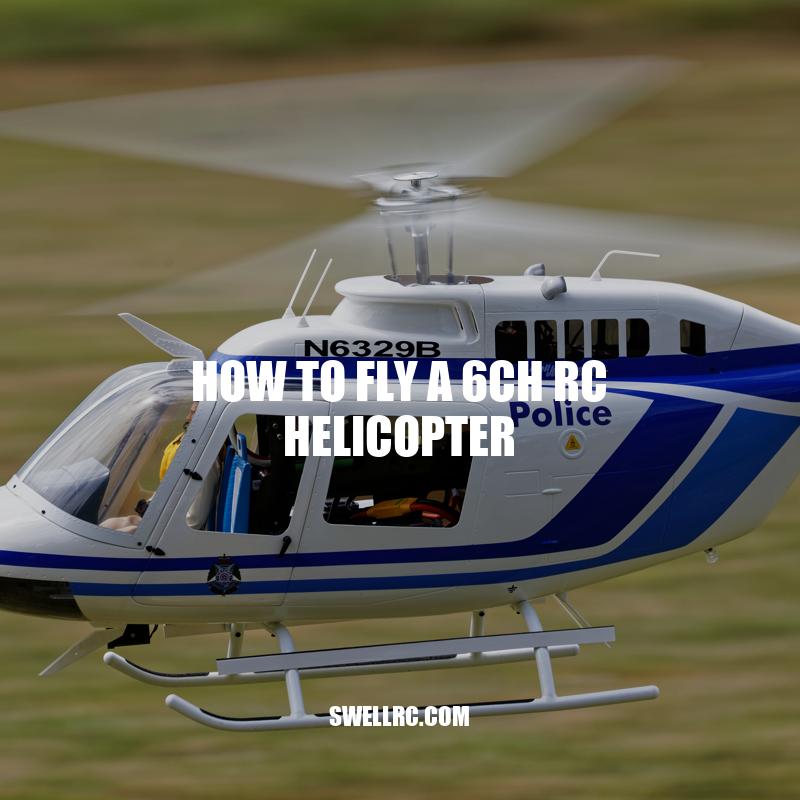How to Fly a 6CH RC Helicopter: Beginner’s Guide
Remote-controlled (RC) helicopters have become a popular hobby for many people worldwide. The advanced technology used in 6-channel helicopters makes them some of the most sophisticated and exciting models to fly. While it can seem daunting to get started, flying a 6CH RC helicopter can be a lot of fun with the right knowledge and skills. Understanding how to fly your 6CH RC helicopter will give you control over your model, allowing you to perform tricks, fly smoothly, and experience the joy of flight. This article aims to simplify the process of flying an RC helicopter and provide helpful tips to guide you through your journey. Whether you’re a beginner looking to take your first flight or an experienced pilot seeking advanced techniques, this article covers everything you need to know about 6CH RC helicopter flying. With patience, practice, and determination, anyone can master the art of flying an RC helicopter.
Getting Started with Your 6CH RC Helicopter
Before taking your RC helicopter off the ground, getting started with the basics is essential. Here’s what you need to know:
– Unboxing and putting together your 6CH RC helicopter involves following the instructions in the manual carefully.
– Familiarize yourself with the remote transmitter and understand how the different channels control specific functions of the helicopter such as throttle, pitch, and yaw.
– Without a doubt, flying spaces are crucial when it comes to 6CH RC helicopters. Choosing an area with minimal obstacles is recommended for beginners. It means less stuff to worry about when you take off or land.
– There are various types of RC helicopter simulators on the market, which can be an excellent tool for practice. Some well-known simulators that you might want to check out are RealFlight and Phoenix RC Simulator.
Investing in a simulator and/or practicing with a cheaper, smaller model before using your 6CH RC helicopter will go a long way in mastering the basics of flying an RC helicopter.
How hard is it to fly a RC helicopter?
Flying a remote control (RC) helicopter can be challenging, but with practice, patience, and some tips and tricks, it can be a rewarding experience. Here are some things to keep in mind:
- Start with a basic model: It is essential to begin with a simple and easy-to-fly model, such as a coaxial or fixed-pitch helicopter.
- Learn the controls: Understanding the controls of the RC helicopter is crucial. They include up and down, left and right rotation, and forwards and backward movement.
- Practice in a large, open space: Practice flying the RC helicopter outdoors or in an open indoor space with no furniture or obstacles.
- Join a club or online community: Joining a local club or online community can provide valuable advice, resources, and support for learning to fly RC helicopters.
If you’re looking for more tips or guidance on how to fly an RC helicopter, there are many websites and products available that can provide more detailed information and support.
Mastering Takeoff and Landing
Once you get comfortable with the basic RC helicopter movements, it’s time to master taking off and landing. Here’s what you need to know:
| Control | Takeoff | Landing |
|---|---|---|
| Throttle | Gradually increase until the helicopter lifts off the ground | Gradually decrease until the helicopter touches down |
| Pitch | Push the pitch forward to maintain altitude | Pull the pitch back to slow down the descent |
| Yaw | Use the yaw control to adjust direction after takeoff | Use the yaw control to align the helicopter for a smooth landing |
Tips for mastering takeoff and landing with your 6CH RC helicopter include:
- Make sure the surface you take off from and land on is flat and stable. Avoid uneven surfaces, grass, and other types of obstacles.
- Gradually increase or decrease the throttle to prevent sudden jerks or movements.
- Use the pitch control to adjust the altitude of your helicopter. Pushing the pitch forward will raise it, and pulling it back will lower it.
- Practice taking off and landing at different altitudes, speeds, and angles to get a better sense of control.
By mastering the takeoff and landing process, you will be able to perform more advanced flying techniques with your 6CH RC helicopter in the future.
How do you master landings?
– Practice makes perfect. The more landings you do, the better you’ll become.
– Pay attention to your speed and altitude. Aim to touch down at the right speed and altitude to prevent a hard landing or overshooting the runway.
– Utilize visual references. Use the runway markings, approach lights, and runway slope to help guide your landing.
– Don’t be afraid to go around. If something doesn’t feel right, it’s better to go around and try again.
– Consider using landing aids such as glide path indicators or precision approach systems if available.
If you’re interested in learning more about landing techniques, there are various aviation websites and courses that offer resources and training.
Navigating in the Air
Now that you have mastered taking off and landing, it’s time to start exploring the 3-dimensional space with your 6CH RC helicopter. Here are some tips to help you navigate in the air:
Understanding Pitch, Yaw, and Roll
– Pitch: The pitch control allows you to angle the blades of the helicopter to control altitude.
– Yaw: The yaw control rotates the helicopter around its vertical axis, allowing you to turn and change directions.
– Roll: The roll control tilts the helicopter side-to-side, allowing you to bank or turn.
Collective Pitch and Altitude Control
– The collective pitch control is what you use to adjust the altitude of your helicopter, allowing you to fly higher or lower.
– Pushing the collective pitch up increases altitude, while pulling it down decreases altitude.
Tips for Transitioning Between Movements
– Practice transitioning smoothly between movements, such as banking into a turn or transitioning from forward to backward flight.
– Be mindful of the wind speed and direction, as it can affect the stability and balance of your helicopter.
Remember to always keep your 6CH RC helicopter within your line of sight and avoid flying in restricted airspaces or near people and animals. With practice, you will be able to navigate the air with ease and perform more advanced maneuvers with your helicopter.
How far will a helicopter fly?
The range of a helicopter depends on various factors such as fuel capacity, weight, altitude, and weather conditions. On average, a helicopter can fly up to 500 miles before needing to refuel. However, some models can fly up to 1,500 miles without stopping. It is important to note that the range may also depend on the purpose of the flight, as a search and rescue mission may require more fuel than a sightseeing tour.
If you’re interested in learning more about helicopters and their capabilities, check out websites such as Helicopter Association International and AeroSavvy. They offer valuable information on different types of helicopters, their features, and usage. If you’re in the market to purchase a helicopter, consider browsing listings on websites such as Controller.com or GlobalAir.com to find the perfect model for your needs.
Advanced Flying Techniques
Once you’ve become comfortable with basic flying techniques and navigation, it’s time to advance your skills and learn some more complex maneuvers. Here are a few advanced flying techniques for 6CH RC helicopter pilots:
Aerobatic Stunts
– Flip: Perform a front flip or backflip by quickly increasing the throttle, followed by a complete pitch reversal and decrease in altitude.
– Roll: Execute a barrel roll by tilting the helicopter to one side while slightly increasing collective pitch, followed by a complete pitch reversal in the opposite direction.
– Inverted Flight: Fly your helicopter orientation upside down by switching the helicopter’s pitch and roll axes.
Gyro Stabilization System
– A gyro system can help stabilize your helicopter and reduce unwanted movements.
– It helps maintain level flight and a steady altitude in windy conditions.
– Look for systems with adjustable gain that can be set according to your flying ability and personal preferences.
Practice Exercises
– Practice hovering in different orientations (left/right, nose/tail-in).
– Practice transitioning between different movements smoothly.
– Set up an obstacle course to improve your maneuvering skills.
Remember to always practice advanced techniques in a safe and controlled environment. Additionally, consider investing in a simulator or buddy box system that allows you to practice flying without risking damage to your helicopter.
What are the basic flying techniques?
Here are some of the basic flying techniques that pilots use:
- Takeoff – During takeoff, pilots need to ensure the plane is at the correct speed and pitch to lift off the ground.
- Climb – Once the plane has taken off, pilots will use a combination of engine power and pitch angle to climb to the desired altitude.
- Cruise – During the cruising stage, pilots maintain a constant airspeed and altitude while monitoring weather conditions and making any necessary adjustments.
- Descent – Prior to landing, pilots must gradually decrease the plane’s altitude while maintaining a safe airspeed.
- Landing – During landing, pilots will reduce the plane’s altitude and airspeed while aligning it with the runway, then touchdown and bring the plane to a stop.
For more information on flying techniques, check out websites such as FAA.gov or products such as Sporty’s Pilot Shop.
Maintenance and Troubleshooting
Proper maintenance is essential for keeping your 6CH RC helicopter in good working condition. Here are some maintenance and troubleshooting tips to consider:
Maintenance Tips
– Clean your helicopter and remote transmitter regularly, and avoid using harsh chemicals or water.
– Check the batteries before flying and replace them if necessary.
– Inspect the helicopter for any signs of wear and tear, including loose screws, damaged blades, and frayed wires.
Troubleshooting Tips
– If your helicopter is not responding or behaving erratically, double-check the batteries and transmitter settings.
– If the helicopter crashes, inspect it for damage and replace any broken or damaged parts.
– If you’re experiencing ongoing issues, consider seeking advice from an experienced 6CH RC helicopter pilot or contacting the manufacturer’s customer support.
Safe Storage and Transportation
– Store your helicopter in a cool, dry place, away from direct sunlight and moisture.
– Consider investing in a dedicated storage container or carrying case for easy transportation.
– Securely fasten the blades and remove the batteries before packing and transporting your helicopter.
Remember to always approach maintenance and troubleshooting with caution and care. Mishandling or improper maintenance can cause damage to your helicopter or result in injury. Additionally, consider browsing online forums and communities for tips and advice from experienced pilots.
What are the 7 steps of troubleshooting?
There are 7 steps to follow when troubleshooting an issue with a product or service:
- Identify the problem
- Gather information
- Isolate the issue
- Determine the root cause
- Create an action plan
- Implement the solution
- Evaluate the results
These steps can be applied to various industries, including technology, customer service, and even writing. By following these steps, you can effectively find the root cause of a problem and implement a solution.
Conclusion
Flying a 6CH RC helicopter can be a thrilling and rewarding experience, but it requires patience, practice, and perseverance. By following the tips and techniques mentioned in this guide, you can learn how to fly your helicopter safely and efficiently, and even master some advanced techniques.
Remember to prioritize safety at all times – wear protective gear, fly in open spaces, and keep your surroundings clear. Additionally, investing in a high-quality 6CH RC helicopter and remote transmitter can make a significant difference in the quality of your flying experience.
We hope this guide has given you a solid foundation to start your journey into 6CH RC helicopter flying. Always remember to be patient and enjoy the process, and who knows? Perhaps you’ll be performing impressive stunts and maneuvers in no time!
If you have any questions or comments about this guide or other 6CH RC helicopter-related topics, feel free to leave them in the comments section or reach out to other online communities for advice and support.



